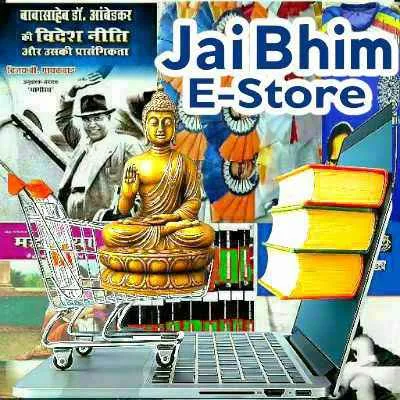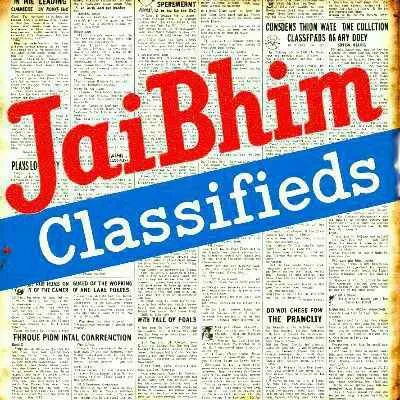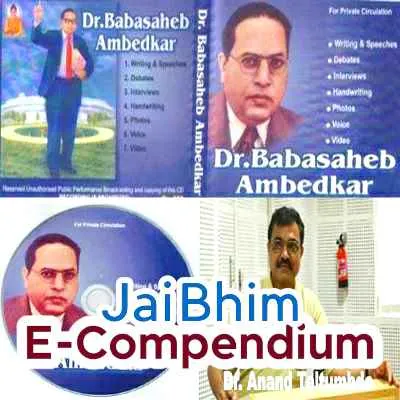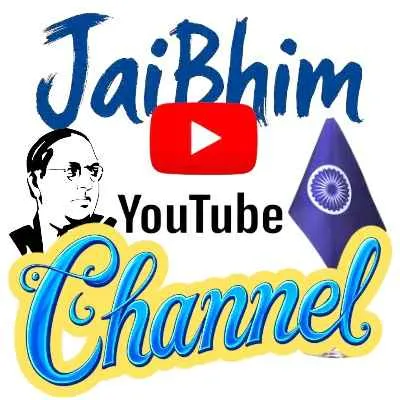Source: E-Compendium on Dr.Babasaheb Ambedkar by dr. Anand Teltumbde
Foreword in Homage
Dr. Babasaheb Ambedkar was a veritable phenomenon of the 20th century. There may scarcely be a parallel indeed in the annals of human history to the saga of struggle that his life represented. Born in the family of ‘untouchables’, he could nonetheless scale the highest peak of scholarship, leadership and statesmanship. When the Hindu caste system had ordained severe punishment for his community for so much as thirsting for education and knowledge, he had secured the highest academic honours from the most prestigious universities of the world and thus conclusively refuted the basic premise of intrinsic inferiority or superiority based on one’s birth proffered by the caste system. For over two millennia, the Hindu caste system had perfected itself into a self-sustaining mechanism of exploitation that fossilised all the social relationship into a caste cauldron and in process had completely robbed the labouring masses like untouchables of their human identity. He had reclaimed for them this identity, breathed political consciousness and galvanised them into a vibrant movement that changed the course of Indian politics. In the epic battle against the vile and complex caste system, he had single-handedly performed the roles of a researcher, a theoretician, an organiser, a journalist, a politician, a leader etc. against all possible odds and still come out with outstanding results. He was among few who dared the contemporary might of the then Indian National Congress and Mahatma Gandhi and stood his grounds even in the face of threats to his life. At symbolical plane, Manu who was the evil enemy in this epic battle as the code giver for the caste system, had to concede defeat and make place for Ambedkar code in the form of the Constitution of India. Eventually, he enacted the biggest religious conversion in the history that ensconced him with his western attire at the place alongside Buddha as the spiritual deity for his people.
During his lifetime Dr. Ambedkar had consistently faced despise, ignominy and insults at the hand of caste establishment. Even after his death, despite his outstanding statesmanship and sterling contributions like drafting the Constitution of India, Ambedkar continued to be despised and ignored by the ungrateful mainstream till the emerging imperatives of electoral politics needed him. Before that, the mainstream even did not concede him so much as leadership of all the untouchables and preferred to belittle him by projecting as a leader of his own community. It systematically either blacked him out from the recorded history or allowed him place in its margins. It strove to confine him to a small community of Maharashtra in which he was born. So effective was this establishment cunning that barring a few pockets outside Maharashtra, where the movement had penetrated in his lifetime, he remained a stranger for a long time to the very people for whom he lived and died. His published writings were all out of print and were available only in a few reputed libraries. A vast unpublished material was embroiled in ownership disputes and hence was decomposing in the custody of courts of law. A few biographies of Ambedkar, among them notably one written by Dhanajay Keer in English (first published 1962) and the other written by Mr. B.C. Khairmode in multiple volumes in Marathi (first volume published in April 1952 and the last volume yet to come), that constituted the earliest source material on Ambedkar had significantly contributed to spread awareness and evoke curiosity about him. However, in absence of an easy access to his original writings he was not even known to the well-meaning intellectual community beyond certain heresies and anecdotes. It is only as a result of struggles of his people that claimed increasing space in contemporary politics and partly influenced by the intrinsic need to woo dalits that the State moved to undertake publication of his writings. The Government of Maharashtra undertook to publish his writings and speeches and came out with its first volume in April 1979. So far 16 volumes have been published which are being translated in Indian languages of some States. Before this project, it needs to be noted that many organisations and individuals claiming allegiance to Ambedkar-thought had brought out reprints of his published writings, compilation of his speeches scattered at many places, and secondary material in his eulogy. It certainly did contribute to spread awareness about the Ambedkar-thought, but due to their meagre resources its reach remained acutely constrained. This constraint was largely overcome when the Government of Maharashtra offered his writings and speeches in well-edited volumes at reasonable prices. Thanks to it, this publication, particularly the ones containing his hitherto unpublished writings, for the first time provided comprehensive introduction to the treatise of his thoughts and expectedly gave impetus to discussions and research work on Ambedkar-thought. The eruption of dalit militancy in the form of Dalit Panthers movement in 70s and the spate of anti-reservation flare ups in 80s, that shook the oppressors as well as oppressed, also significantly motivated the study of Ambedkar-thought.
As the development process picked up momentum in the post-independence period, the contradiction among the ruling classes started growing which in turn manifested into many political parties opening their shops in the electoral market of India. The heat of competition impelled them to see the importance of the vast market segment constituted by the dalit votes. The latter, being one-fourth of the total market, was significant enough even in any electoral constituency to tilt the scale. The broad strategic response possible was either to fragment this segment, which was easy to do along the existing sub-caste fissures, so as to reduce it to insignificance level or to consolidate it and lure it onto ones side. However, with the passage of time the trend of dalits transcending their sub-caste boundaries and getting emotionally bonded around Ambedkar was increasingly becoming visible. As such the former negative strategy became less attractive and was ostensibly adopted by only the hard-core fascist parties. The large-scale adoption of the latter positive strategy meant competition in claiming Ambedkar’s legacy that manifested in hijacking Ambedkar away to the camps of the ruling classes. This cooptation of Ambedkar by the mainstream politics essentially resulted in significant displacement of the genuine Ambedkar by the deformed Ambedkar in the gullible dalit masses. The universal eulogy reflected from the process of cooptation only helped latent tendency towards deification and iconisation of Ambedkar and that virtually made it impossible to review Ambedkar-thought as a living body in the context of changing times and circumstances without incurring the sin of sacrilege.
While the imperatives of electoral politics has changed the attitude of State to the extent of cooptation of Ambedkar, the civil society still reflects the casteist prejudice against him. The process of globalisation driven by the imperialist institutions like IMF and the World Bank since 1980s and which got formally adopted by the Government of India in 1991, in the crisis-ridden economic context unleashed new contradictions that manifested among other, the resurgence of the Hindu fundamentalism. These forces blatantly upheld everything that appeared conclusively condemned by liberal ethos during the post-independence decades. Ambedkar, as a symbol of these ethos naturally became the target for their vicious attack. Currently these attacks could be seen in the form of defilement of his statues and the pseudo-intellectual cunning represented by some reactionary individuals. Both, the cooptation as well as the vilification of Ambedkar are detrimental to the dalit interests. However, the former is much more injurious than the latter. While the latter represents open opposition to the ideology the former would mean adulteration of the ideology itself to suit the State interests. Unless, one is thorough about the ideological nuances and vigilant about its operative manifestations, it becomes extremely difficult to arrest or contain the damage done through the process of cooptation. The ideological weakness in turn incapacitates the struggle in the realm of the civil society and even its organisational apparatus. The present state of fragmentation of the Dalit movement may be largely attributable to this ideological weakness.
The problems of dalits are far from being resolved. Despite the constitutional provision to the contrary, they are being discriminated against day in and day out. This discrimination ranges from the subtle prejudice exercised against them in the modern sectors of economy in the urban areas to the stark practice of untouchability in the rural areas. Another significant constitutional influence on the dalits has been through the policy of reservation in politics, education and services. While, this policy implemented sincerely in political arena as it basically serves the interests of the establishment and provides legitimacy to the system, its implementation in other two spheres has been utterly pathetic. Even over the five decades of its implementation, the unsatisfactory representation of dalits particularly in the higher echelon of services and consistent denial of their dues by the executive as well as judiciary has amply bared the fangs of the State. The condition of majority of dalits in rural areas is no better than it existed five decades before. Pulverisation of dalit politics under the rollers of electoral allurements has incapacitated the dalit movement. The dalits masses today feel utterly cheated but they do not have wherewithal to see by whom.
The typical responses to the empirical state of the dalit masses and their movement are essentially of two types. The first one tends to externalise the failure by accusing the savarnas of cheating or of failing to implement the promises made in the Indian Constitution. The second one tends to internalise it in terms of failure of practice by dalits, particularly the dalit leaders and intellectuals. It accuses the dalit intellectuals and politicians of having snapped themselves off their roots and of betraying the dalit movement. They have come to be a class for itself. Both represent partial truth at some level. These very allegations however tend to submerge the basic question about the efficacy of strategy of the movement and in turn of its ideology that failed to firstly envisage and thereafter arrest the undesired happenings. As for the leaders and the dalit intellectuals (or more correctly the educated dalits), they represent the output of the movement. Insofar as Ambedkar represents a fountainhead of both the strategy as well as the ideology of the dalit movement, his thoughts should constitute essential terrain to search the causes of these failures.
The difficulty in this enterprise is immense despite much of Ambedkar’s writings and speeches are available in English language and a plethora of secondary and tertiary literature having been published in recent times. Ambedkar lived through a turbulent period of the Indian history, creating space for the dalit movement within the interstices between the movements of the contending classes with his meagre resources. His thoughts are therefore heavily contextised by the dynamics of this contention. While simultaneously trying to build the ideological foundation for the movement, they tend to reflect expediency of survival and his anxiety to maximise the short-term gains for dalits. While it may not be difficult to discern the ideological strains in his writings, the task of its precise definition (exaction) poses problematic on two counts. First, many a familiar construct and concept in his usage do not bear their familiar meanings as indicated by him. For instance, while he adores the dictum of ‘liberty, equality and fraternity’ propounded by Roussou that blazed the French Revolution, he faults it and finds its perfection in Buddha; while he reflects western liberalism and admires its proponents, he denies being a liberal; while he appears to accept the ideal of socialism in Marxism, he does not seem to talk about the scientific socialism in it and rather finds his dream world in Buddhist Sangha; while he accepts the premise that there are classes in society in contradiction with each other, he rejects the imperative of class struggle and foresees the class conciliation through the constitutional methods. One could easily go on listing the similar problematic of language. Indeed when eventually, when he embraced Budhhism, it was not to be the Buddhism familiar to the world but the one he interpreted to be propounded by Buddha, the Dhamma of Buddha essentially of his conception. Secondly, while he grants one freedom to test him out on the principles of rationality and on the basis of experience, he appears inaccessible for the purpose, well beyond the impregnable fortification erected by the powerful vested interests.
The collapse of so called socialist regimes and consequent emergence of the unipolar world order is casting its savage shadow on the struggles of the oppressed people all over the world. The ideology of neo-liberalism with the backing of modern media and military might is fast marginalising the resistance and transforming the world into a market where a person is granted a hallowed identity of a customer. His claim to liberty, equality and fraternity is conceded in proportion to his purchasing power in the market where everything is a commodity. The impact of this ideology is already visible in terms of gnawing inequality that is compounding with every passing year. The odds for the oppressed people are indeed mounting on every front. They face an unprecedented ideological crisis today for effectively articulating their emancipatory struggles. They need to objectively review the weapons in their ideological armoury, to identify the ones that could be regenerated, the ones that could be modified and the ones that need to be altogether replaced. Ambedkar-thought that constituted weaponry of dalits and oppressed people in India, has certain attributes that could be used to recreate the new weapons. It has certain regenerative potential to be of continued relevance provided it is used in the desired manner and not monopolised by the vested and sectarian interests. The time has come to consolidate the ideological armour of the have-nots of the world and the study of Ambedkar-thought here is envisaged from that viewpoint. It is imperative that it is made available to many people in the world. It is necessary that it be subject to review from many viewpoints. It is vital that it is evaluated on the basis of concrete experience. One respects contributions of great people not in blind allegiance but by serving the cause that he or she lived and died for. As Ambedkar said of great people and demonstrated in relation to Buddha whom he undoubtedly adored most, following him lies in not cold storing his thoughts in a time vault but in constantly using it in the struggle, constantly cleaning and honing it for its usage is bound to dirty it and deform it, constantly review its effectiveness as with the passage of time it might need supplement or replacement. Only the concerted struggle of many committed people can restore true Ambedkar to his people.
The objective behind bringing out this volume of writings by and directly associated with Dr. Babasaheb Ambedkar in CD ROM is to promote their study, research and evaluation for not only understanding but also enriching the Ambedkar-thought as the living guide of the movements of dalits and all oppressed people of the world. Information technology in CD ROM basically helps in this promotion through increased ease of handling and speed of textual search vis-à-vis the bulky material in form of books. An opportunity is taken to include images of Ambedkar and the dalit movement of his times on the CD ROM. Images also constitute important context. Besides, many of these images being digitised from the dying sources would provide a lasting photo album with the people beholden to Ambedkar. Also, a voice clip of the speech delivered by Ambedkar and a video clips that we could lay our hands on are also enclosed which might bring Ambedkar live for many people.
The material used came from varied sources. They could be divided into two main categories. One, the writings that are published by the original publishers and subsequently by many others, and two, the hitherto unpublished writings that became first time available in the form of the publications of the Government of Maharashtra.
Due care has been taken of the accuracy of the text. However, considering the magnitude of the task and fickle nature of handling soft copy, one could not be absolutely sure of the typographical aspect. I would like to own up all the blame for these shortcomings. It is hoped that the readers would provide their generous feedback as they notice them so as to progressively make the text absolutely error free. With regards to spelling and grammar, no attempt has been made to correct the text except for the obvious errors that could be attributable purely to printer. The text in Sanskrit has been transliterated into familiar English, which may not stand the test of any discerning reader. They and the people knowing Sanskrit are advised not to rely upon these transliterations in their critical usage and get to the original source. My difficulty was in terms of fonts and peculiar manner in which Sanskrit is written in. In my assessment, it was not so crucial for the normal readers as to get into technical complexity of embedding Devnagari fonts. Based on the readers’ feedback, it can be done later in the revised version of the CD.
Many people helped me at various stages in accomplishing this huge task. While it may not be feasible to recall all of them in formal manner, it would be utter ungratefulness not to acknowledge the contributions of some friends and colleagues like Ms. Monisha Nair, Mr. C. Elangovan, Rajesh Kannaujia, Ravindra, Rajesh Kumar N. and Ramesh Dekate (in text preparation); C. A. Saboo and Senthil Kumar (in technological solutions); K.S.Sivakumar (in multimedia aspects) and Manohar Raipure (coordination). C. Elangovan particularly shouldered my entire burden when my right hand and shoulder failed to work in process during the last but crucial phase of the project. I am indeed indebted to all these friends without whose help and assistance this task would not have been accomplished in the form you find it today. In my times of ordeal, my daughter Iskra also has been a great help in redoing many of the tables that got distorted in OCR. She also helped me in captioning the photographs. I am grateful to Mr. R. G. Ruke, the caretaker of the material preserved in Rajgruha for making many poster photos available to me for digitising. He has also helped us in preparation of captions for the photographs. Similarly my thanks are due to Mr. Vasant Moon and Mrs. Meenakshi Moon for providing me with the photographs and manuscripts in their possession for digitising. My friend Dr. L. K. Chavda of Rajkot who came to my rescue by organizing in short time, the audio cassette of Parliament-speech of Babasaheb Ambedkar when the available material with me was not too clear. As I learnt later, it was made available to him by Mr. D. J. Somaiya, an old friend of mine and committed Ambedkarite from Rajkot. I thank both of them. My thanks are also due to Mr. C. C. Hadke (ONGC, Mumbai) who provided the video clip. The embedded video clip is basically an edited version of this video with a changed script. I thank my friend Mr. R. Mohan who provided the voice over to this script. Much of the encouragement flowed from the Dalit e-Forum and friends like Raju Kamble, Niranjan Waghmare, Balram Sampla and Shashi Chandrasekhar. I am thankful to them. Many individuals and organisations, particularly the Ambedkarite and Buddhist organisations in UK came forward to shoulder the responsibility of distributing this e-compendium among the students and researchers of Ambedkar-thought and the other activists in the movement of oppressed people. They all deserve a grateful mention here.
I hope this humble contribution proves helpful to all the comrade readers engaged in the task of making this world a little better place for the vast majority of mankind that is being variously exploited by few.
Anand Teltumbde
Mumbai, January 1, 2000












